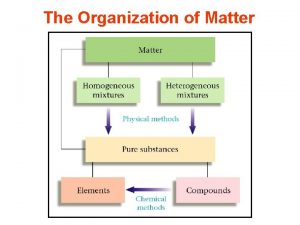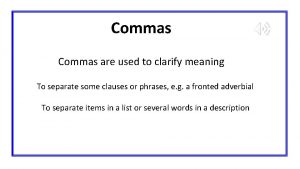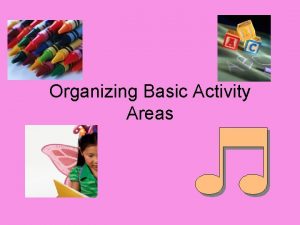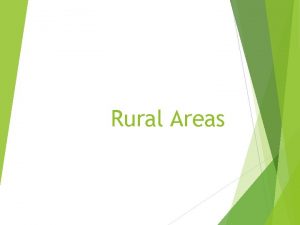Social services Childrenadults separate areas of activity Social























































- Slides: 55

Social services Children+adults –separate areas of activity





Social services: who for? • • • Elderly Disabled Children esp. those at risk Mentally ill Long-term ill Anyone “vulnerable” – asylum seekers

Children’s social care

Social services: who provides? Social care – “multi agency approach” – often more than one provider involved. Central government sets framework of duties/responsibilities/standards Providers are: • Local authorities (social services providers are counties; unitaries; London boroughs) • The NHS – Primary Care Trusts • The Police (children at risk/abuse issues) • Charitable groups eg NSPCC/Barnados

Children’s Services • Protecting at risk children one of most important jobs of social services • Arrangements changed fundamentally by Children’s Act 2004 (post-Lord Laming inquiry into death of Victoria Climbie) • Policy of “Every Child Matters” introduced • Local Safeguarding Children’s Boards • Act also established Children’s Services Departments for local councils – bringing education and social care for children together

Baby P – Lord Laming report 2009 • • Failure of agencies to share information Social workers over-stretched Red-tape+form filling hampering front-line staff “Over-complicated, lengthy and tick-box assessment+recording system. ” • Child protection seen as ‘Cinderella Service’ • Too many authorities failed to adopt his reforms following Victoria Climbie report in 2000 • “It seems like they have to do all this form filling. Their bosses make them do it but it makes them forget about us” – 16 -year-old in care

Care of children Role of social services (the council): • Protection (safeguarding) • Promote general welfare of children • Encourage children to be brought up in family setting • Work with parents in child’s best interests • Provide accommodation for children where necessary (Tracy Beaker, fostering)

Local Children’s Safeguarding Boards • Set out how different agencies will collaborate to deliver services/monitor effectiveness

Children at risk - Child Protection Plans • Plans are drawn up by professionals following initial child protection conference • Social services – (the council) - coordinate action to safeguard children through “inter-agency” plan • Plans set out how child is to be protected • Children may be taken out of home

Children taken into care – why? Underlying principle: Where children are at significant risk of harm and there is on-going risk Types of harm: • Neglect • Physical Abuse • Sexual abuse • Emotional abuse • Children can be registered under more than one category

Care Orders • • • Only for children under 17 Applications for such orders go to Family Court Orders are applied by councils where: Child is at risk of significant harm and care is below reasonable parental standard KCC – 261 care orders sought in 2013 -14 at average cost of £ 5, 000

Care Orders • Social services assume parental responsibility but parents must have reasonable access • Interim care orders: where council is seeking full care order. Last max. eight weeks, unless court grants renewal

Supervision Orders • Where child is placed under supervision – but not necessarily taken into care - with councils having a lesser duty to “advise, assist and befriend. ” • Families must be allowed to bring up child if possible • Can be made for abandoned/lost children

Emergency Protection Orders • Where child is deemed to face an immediate danger and harm • Made by courts • Last up to 8 days • Can be extended by court if satisfied risk still exists • Parents can challenge after 72 hours

Serious Case Reviews • Purpose of SCRs: • Are there lessons to be learned from the case about how professionals and agencies worked? • Identify clearly what those lessons are, how they will be acted on, and what is expected to change as a result • Improve inter-agency working

SCRs – when? • If child sustains a potentially lifethreatening injury or serious injury through abuse or neglect • If child has been subjected to serious sexual abuse • A parent has been murdered • A child has been killed by a parent with a mental illness • If case gives rise to concerns about interagency working to protect children




Care Homes • Councils must provide Community Homes for children in care • Private homes must be registered by the Commission for Social Care Inspection • Homes may be run by charities, eg Barnados • Usually mixed (boys and girls)

Fostering • Can be short or long term • Seen as preferable to care home environment • Foster parents: no legal custody or full parental rights (but may choose to adopt later) • Must be approved by social services • Are paid+have allowances for clothing/holidays etc

Fostering ii • Prospective foster parents vetted by social services to assess if appropriate • Social services retain right to make regular spot checks – can remove children if necessary • Required to undergo statutory training


Adoption • Eligible children must be < 18 • And be a child for whom returning home is not possible • Adoption orders sever all legal ties with natural birth family • Confers parental rights and responsibilities on new adopting family

Adoption ii • Adoptive parents must be > 21 • Be able to provide stable + permanent home • Need not be married; can be single; same sex couples can adopt • No upper age limit • No bar against those who are disabled adopting • Adoption must be through an approved Adoption Agency or Voluntary Adoption Society approved by Secy. Of State


Adoption in Kent • 2006 – 96 children adopted • 2010 – 57 children adopted But only 28 approved adopters And… 90 other children waiting “It is clear that there is a desperate imbalance between the number of those children and the number of approved adopters. The fundamental weakness in Kent is clear. ” Martin Narey, ex-head of Barnados



Adult social services

Growing pressure • We are an ageing society – people now living much longer than they were • More people over 65 than under 16 for the first time • 10 m people are over 65 – by 2050, forecast is 19 m • In 1900, 1% of popn. was > 65; 2000 it was 7%; by 2050, it will be 20% • Number of people working beyond retirement age (65) has doubled in 10 years to 900, 000

Growing pressures… • Fastest growing sector of the population is the over-80 s • Currently, 3 m are over age of 85 • Forecast is that will double to 6 m by 2030 • Of govt spending on benefits – 65% of DWP budget goes on older people (£ 100 bn in 201011) • NHS spending on retired households: £ 5, 200 • NHS spending on non-retired: £ 2, 800




Who should pay?

Dilnot Commission – fair funding • Government set up inquiry because of concerns about affordability of care – sustainability+fairness • Driven by concern that anyone with £ 23, 000 assets faces unlimited care costs • Reported in June 2011

Dilnot Commission recommendations • Each person’s contributions to care costs should be capped. After cap reached, state support kicks in • Cap should be between £ 25, 000 -£ 50, 000. £ 35, 000 • National eligibility criteria about who qualifies for care – currently set locally • Cost to UK – approx £ 1. 7 bn

Govt. response to Dilnot • Accepts principle of a cap • Treasury said cap will be £ 75 k not 35 k • £ 35 k cap would cost govt. £ 1. 7 bn Issues… • Would insurance companies come in at that level? • Public not interested in planning for their care

Adult social services - Community Care • NHS and Community Care Act 1990: shifted responsibility from NHS to local govt. • Aim: to move away from institutional living to independent living • Care is provided for problems associated with: • Ageing • Mental illness • Learning difficulties • Physical/sensory impairments • NHS+Social services required to make Partnership Arrangements for care of individuals

Community Care: How it works • Anyone with disability or any other social care need is entitled to a needs assessment: • Old age/physical weakness • Physical difficulties • Sensory difficulties • Learning disabilities • Mental health problems

Community care: how? • Assessments gauge what kind of help might be needed and can be provided in accordance with “eligibility criteria. ” • Councils usually have a system that grades level of need: for example, critical, substantial, moderate or low • People most at risk given priority • Individuals are given a care plan setting out what will be provided and by who • Care may be secured through system of “direct payments”

Care plans • • Services to be provided Who will provide them Contact for issues or problems How reviews can be asked for if circumstances change

Community care – what kind of care? Domiciliary care services: such as – • Meals on wheels • Help with personal bathing or shopping • Respite care (for carers too) • Special equipment added to home – ramps; adapted furniture; stair rails • Services often contracted out to private sector/voluntary sector. Charges can be made; often free

Community care – other help • Support for deaf and blind • Day care services – organise activities for people • Recuperative and intermediate care services: short-term (few weeks) and intensive help to help recovery after illness; fall or other crisis. May be at a care home • Respite care for carers, who may themselves need help (such as a break or holiday) • Residential care in home – often bought in by council but how much is paid subject to means-testing

Who regulates – the Care Quality Commission (CQC) • Independent regulator • Regulates all health and adult social care services in England provided by NHS, local authorities, private companies or voluntary organisations • Protects the rights of people detained under the Mental Health Act.

Care Quality Commission • Care homes • Domiciliary care providers • Hospitals • In all cases to “ensure compliance with required standards of care and welfare”

CQC ii • All health and adult care providers must register with CQI (Health and Social Care Act 2008) • Includes NHS trusts • Registration designed to ensure compliance with essential standards of quality and safety • Has power to conduct unannounced inspections • Can issue fines and fixed penalties • Withdraw registration, for eg from hospitals failing to meet cleanliness standards; close down departments or withdraw operating licences from entire hospital


Adult Safeguarding Boards • Multi- agency: councils; police; NHS Role: • Approve policy, procedures and guidance for safeguarding • Approve a training strategy • Monitor performance of statutory agencies • Hold agencies to account • Publish annual report

 Reactants, products, and leftovers
Reactants, products, and leftovers Debye huckel limiting law
Debye huckel limiting law What is aoa in project management
What is aoa in project management Activity 1 introductory activity
Activity 1 introductory activity Activity 1 activity 2
Activity 1 activity 2 Activity 3 explore me more
Activity 3 explore me more Activity 1 activity 2
Activity 1 activity 2 Areas of social psychology
Areas of social psychology Integrated services vs differentiated services
Integrated services vs differentiated services Wake county human services community services center
Wake county human services community services center What is an introductory clause
What is an introductory clause Separate result unknown
Separate result unknown Separation of mixtures
Separation of mixtures How to separate raisins and flour
How to separate raisins and flour How to separate salt and sand chemistry
How to separate salt and sand chemistry Cleanse the palate after a rich dinner and before dessert
Cleanse the palate after a rich dinner and before dessert Guest city services bill
Guest city services bill Separate result unknown
Separate result unknown Horizontal
Horizontal Chet douglass a separate peace
Chet douglass a separate peace Quadratic probing
Quadratic probing Separate chaining
Separate chaining Are english literature and language separate gcses
Are english literature and language separate gcses Separate piece of paper
Separate piece of paper Commas to separate adjectives
Commas to separate adjectives In fact commas
In fact commas A sign separates items in a list
A sign separates items in a list Commas to separate adjectives
Commas to separate adjectives Separate result unknown
Separate result unknown A separate peace setting
A separate peace setting Sorting mixtures
Sorting mixtures Centerlines are used to separate the title block and notes.
Centerlines are used to separate the title block and notes. Classi sociali rigidamente separate
Classi sociali rigidamente separate Why is separating mixtures important
Why is separating mixtures important How to separate mechanical mixtures
How to separate mechanical mixtures How to separate sand and finely ground polystyrene foam
How to separate sand and finely ground polystyrene foam A collection of separate application programs bundled
A collection of separate application programs bundled Chapter 1 a separate peace
Chapter 1 a separate peace The pearl chapter 6 comprehension questions
The pearl chapter 6 comprehension questions One's self i sing
One's self i sing Example of magnetism in separating mixtures
Example of magnetism in separating mixtures How separating funnel works
How separating funnel works Independent assortment in metaphase 1
Independent assortment in metaphase 1 What is used to separate parts of any series
What is used to separate parts of any series Using commas to separate clauses
Using commas to separate clauses Chapter 8 separate financial statements
Chapter 8 separate financial statements Do sister chromatids separate in meiosis
Do sister chromatids separate in meiosis A separate peace test
A separate peace test A separate peace quiz
A separate peace quiz Phil latham a separate peace
Phil latham a separate peace Nothing can separate even if i ran away
Nothing can separate even if i ran away Hash separate chaining
Hash separate chaining Decanting
Decanting Integrated quotation
Integrated quotation Crossing-over occurs during
Crossing-over occurs during Lane positions
Lane positions












































































